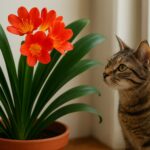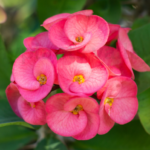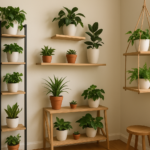Get ready to dive into the enchanting world of Hoya Sunrise!
Today’s detailed guide is all about this stunning hoya variety that shares its growth habits with the beloved Hoya carnosa.
In this comprehensive guide, we will dive into the fascinating world of Hoya Sunrise.
We will discuss its origins and characteristics and growing and caring conditions.
The best part? Caring for Hoya Sunrise is as easy as can be!
Additionally, we will touch upon common pests and diseases that may affect your Hoya Sunrise and provide effective solutions to keep your plant healthy and thriving.
Join us on this exciting journey as we unravel the secrets of this mesmerizing hybrid hoya cultivar.
Before we move on, let’s quickly go through some basic information that will set the stage for our exciting journey ahead.
| Common Name | Hoya sunrise, wax plant, porcelain flower |
| Scientific Name | Hoya lacunosa x obscura ‘Sunrise’ |
| Family | Apocynaceae |
| Genus | Hoya |
| Plant type | Tropical vine |
| Native Habitat | Southeast Asia, Australia |
| USDA Hardiness Zone | 9- 11 |
| Light | Bright indirect light |
| Soil | Well-draining, Acidic, And neutral |
| Temperature | 65-80°F |
| Humidity | High |
| Water | Moderate |
| Fertilizer | Slow-release fertilizer |
| Pruning | Occasional |
| Repotting | Every two years |
| Toxic to Cats & Dogs | Mildly Toxic |
| Toxic to Humans | No |
| Pests | Mealybugs, Aphids, Spider mites, Scalenuts |
| Diseases | Root rot, Leaf Spot, Powdery Mildew |
What is a Hoya Sunrise?

Hoya Sunrise is a hybrid plant that was created by Michael Miyashiro in the early 1990s. It is a cross between Hoya lacunosa and Hoya obscura. Hoya Sunrise is a vining plant that can grow up to 10 feet long. It has glossy, heart-shaped leaves that are green with a maroon tint. Hoya Sunrise produces fragrant, star-shaped flowers that bloom in clusters. The flowers are white with a yellow center.
Hoya Sunrise is a popular plant for a number of reasons. It is easy to care for, it is beautiful, and it has a sweet fragrance. Hoya Sunrise is also relatively rare, which makes it even more desirable.
Origin

These stunning plants have their roots firmly established in warm to hot tropical climates, characterized by medium to high humidity levels.
Originating primarily from Southeast Asian countries, they also thrive in the northern regions of Australia, including China, Thailand, and Indonesia. Hoya plants, commonly referred to as wax plants or wax vines, belong to the Apocynaceae family.
Michael Miyashiro is a plant breeder who specializes in Hoya plants. He has created many popular Hoya hybrids, including Hoya Sunrise. Hoya Sunrise was first introduced to the market in 1992. It quickly became a popular plant due to its beautiful flowers and its easy care requirements.
Hoya Sunrise Scientific Name
The scientific name for Hoya Sunrise is Hoya lacunosa x obscura ‘Sunrise’. It is a hybrid of Hoya lacunosa and Hoya obscura, two species of Hoya native to Southeast Asia. The common name is Hoya Sunrise. There are other many common names by which you may call your Hoya Sunrise, such as:
- wax plant,
- wax vine, or
- wax flower.
Unique Features Of Hoya Sunrise
Hoya Sunrise has several unique features that make it a standout plant among other houseplants. Let’s explore these distinctive characteristics that contribute to the allure of Hoya Sunrise:
Variegated Foliage
The most unique feature of Hoya Sunrise is its beautiful variegated foliage.
Each leaf displays a captivating blend of shades, including vibrant pink, rich green, and creamy white.
The variegation patterns can vary from leaf to leaf, making each plant truly unique.
This stunning foliage is the main attraction of Hoya Sunrise.
Compact Growth Habit
Hoya Sunrise has a compact growth habit, making it suitable for both indoor and outdoor cultivation.
It is a trailing vine that can grow up to several feet in length.
This growth pattern makes it an ideal choice for hanging baskets or trailing positions.
Hoya Sunrise Flower
Hoya Sunrise produces clusters of delicate, star-shaped flowers. These flowers can vary in color, often displaying shades of pink or white.
The Hoya Sunrise flowers are sweat smell, almost honey-like.
One notable feature of Hoya Sunrise is the longevity of its flowers. Unlike many flowering plants, the blooms of Hoya Sunrise can last for several weeks or even months, adding an extended period of beauty to the plant.
Hoya Sunrise Height
Hoya Sunrise is a vining plant that can reach a moderate height when allowed to grow freely.
The average height of a mature Hoya Sunrise plant can range from 6 to 8 feet in a hanging or trailing position.
However, the height of Hoya Sunrise can be controlled and influenced by various factors, including the growing conditions and the way it is cultivated.
With proper pruning and training, you can maintain your hoya plant at a desired height.
Low-Maintenance Nature
Hoya Sunrise is relatively easy to care for.
It is known for its tolerance to a variety of growing conditions, including moderate light levels and average humidity.
Hoya Sunrise has succulent-like qualities, storing water in its leaves, which enables it to withstand periods of drought.
You may also like
Hoya Sunrise Plant Care
Caring for Hoya Sunrise is relatively the same as for Hoya New Guinea Ghost. With proper attention to its needs, you can ensure the health and vitality of this beautiful plant.
Here are some essential care guidelines for Hoya Sunrise:
Lighting
Hoya Sunrise thrives in bright, indirect light. Place it near a window that receives filtered sunlight or provide it with bright artificial lighting.
If your window receives intense sunlight, consider using a sheer curtain or placing the plant a few feet away from the window to protect it from direct rays.
Inadequate light can result in leggy growth and less vibrant foliage, so finding the right balance is essential.
Temperature
Hoya Sunrise prefers average to warm temperatures between 60°F and 80°F (15°C to 27°C). It prefers warm conditions, so avoid exposing it to cold drafts or temperatures below 60°F (15°C).
Protect the plant from drafts and sudden temperature fluctuations, especially during the winter and summer months
Sudden temperature fluctuations can stress the plant and lead to leaf damage.
Watering
Water Hoya Sunrise when the top inch (2.5 cm) of soil feels dry. It’s important to avoid overwatering, as Hoya plants are susceptible to root rot.
Ensure that the pot has drainage holes to allow excess water to escape. During the winter months, when the plant is in a dormant phase, reduce watering frequency.
Humidity

Hoya Sunrise appreciates moderate humidity levels but can tolerate average household humidity. You can increase humidity in many ways:
Humidifier: Using a humidifier is an effective and convenient method to maintain consistent humidity levels around the plant.
Pebble Tray: Fill a tray or saucer with water and place pebbles or stones in it. Set the potted Hoya Sunrise on top of the pebbles, ensuring that the water doesn’t touch the pot’s bottom. It increases the humidity around the plant.
Misting: Regularly mist the leaves of the Hoya Sunrise using a spray bottle filled with room-temperature water. This helps to mimic the natural humid conditions it thrives in.
Grouping: Grouping plants together can create a microclimate of increased humidity due to the collective transpiration of the plants. Place the Hoya Sunrise near other houseplants to benefit from their combined humidity output.
Soil
The Hoya Sunrise thrives in well-draining soil that retains some moisture while allowing excess water to drain freely.
Use a well-draining potting mix for Hoya Sunrise, such as a mixture of peat moss, perlite, and orchid bark. This type of soil allows water to drain freely and prevents waterlogging.
Compost or well-rotted organic matter can be incorporated into the soil mix to enrich it with essential nutrients and promote healthy roots.
This allows the roots to breathe and promotes healthy growth.
The ideal pH range for Hoya Sunrise is slightly acidic to neutral, around 6.0 to 7.0.
Most commercial potting mixes are formulated within this pH range, but if you’re preparing your own mix, ensure it falls within the appropriate pH parameters.
Ensure that the pot you choose has drainage holes at the bottom to allow excess water to pass.
Proper drainage prevents waterlogging and the risk of root rot.
Fertilization
Feed Hoya Sunrise with a balanced, water-soluble fertilizer formulated for houseplants.
During the growing season (spring and summer), fertilize the plant once every two to four weeks. Reduce or stop fertilization during the dormant period in winter.
Pruning
It can help to maintain a compact and bushy shape for Hoya Sunrise.
Remove any yellowing or damaged leaves promptly to encourage new growth. Trimming back leggy vines also promotes bushier growth.
Use clean, sharp pruning shears or scissors to make clean cuts just above a leaf node. Pruning can be done throughout the year as needed. Always sanitize your pruning tools before use to prevent the spread of diseases.
Support and Training
If desired, provide a trellis or moss pole for Hoya Sunrise to climb. This allows the plant to showcase it’s trailing or climbing growth habit. Gently guide the vines to the support structure to encourage upward growth.
Repotting Hoya Sunrise
Repotting becomes necessary when your Sunrise Hoya outgrows its current pot or the soil becomes compacted. When repotting, follow these steps:
- Choose a new pot that is one size larger than the current pot, allowing for sufficient room for root growth.
- Gently remove the plant from its current pot, being careful not to damage the roots. If the roots are tightly packed, you can gently loosen them to encourage outward growth.
- Place fresh soil in the new pot and create a small mound in the center. Position the Hoya Sunrise on top of the mound, spreading the roots outward.
- Fill the remaining space with soil, ensuring that the plant is at the same level as before. Lightly press the soil around the plant to secure it.
- Water the newly repotted Hoya Sunrise thoroughly to settle the soil and promote root establishment.
Tips: Remember to monitor the plant closely after repotting to ensure it adapts well to its new container. Adjust your watering routine as needed, and provide appropriate care based on the specific requirements of your hoya sunrise.
Hoya Sunrise Propagation
Hoya Sunrise can be propagated through stem cuttings.
- Select a healthy stem from the parent plant that has at least two to three nodes (points where leaves emerge).
- Using clean and sharp pruners or scissors, make a clean cut just below a node leaving one or two leaves at the top.
- If desired, you can apply a rooting hormone to the cut end to promote root development (optional).
- Place the cutting in a container filled with a well-draining propagation mix, such as a combination of peat moss and perlite.
- Keep the soil consistently moist but not waterlogged and provide bright, indirect light.
- After a few weeks, you should start to see new roots forming.
- Once the roots are well-developed, you can transfer the cutting to a small pot with regular potting soil.
Common Leaf Issues of Hoya Sunrise
While Hoya Sunrise is generally a hardy and resilient plant, it can still encounter leaf issues from time to time. Here are some common leaf issues you may come across when caring for Hoya Sunrise:
Yellowing Leaves
It can occur due to various reasons, including overwatering, underwatering, nutrient deficiencies, or natural aging.
Assess the plant’s watering routine and adjust accordingly, ensuring the soil is neither too dry nor waterlogged.
Consider fertilizing the plant with a balanced fertilizer to provide the necessary nutrients.
If the yellowing is limited to older leaves at the bottom of the plant, it may be a natural process as new leaves emerge.
Brown Spots or Edges
Brown spots or edges on the leaves can be caused by inconsistent watering, underwatering, or low humidity.
Check the soil moisture regularly and water the plant when the top inch (2.5 centimeters) of soil becomes slightly dry.
Increase humidity levels by misting the leaves or using a humidifier.
Avoid using water with high salt content, as it can cause leaf burn.
Leaf Curling
Leaf curling can be a response to dry air, low humidity, or inadequate watering.
Increase humidity levels around the plant by misting the leaves or placing a tray of water nearby.
Ensure the plant receives adequate watering, allowing the soil to dry slightly between waterings.
In some cases, curling leaves can also be caused by excessively high temperatures or direct sunlight, so adjust the plant’s placement accordingly.
Leaf Spotting or Discoloration
Leaf spots can occur due to fungal or bacterial infections.
Treat any visible pests with appropriate measures, such as insecticidal soap or natural predators.
For fungal or bacterial issues, consider using a fungicide or adjusting environmental conditions to discourage disease development.
Remove and dispose of severely affected leaves to prevent further spread.
Tips: Assess the plant’s conditions and adjust as needed, providing stable and suitable growing conditions.
Regularly inspecting your Hoya plant leaves can help you identify and address any issues promptly.
Pests and Diseases Of Hoya Sunrise
While Hoya Sunrise is generally a resilient plant, it can still be susceptible to certain pests and diseases.
Pests
Mealybugs (Pseudococcidae): Mealybugs are small, cotton-like insects that gather in clusters. They can be found on leaf joints, leaf undersides, and along stems. Infested areas may appear white or have a sticky residue.
Remove mealybugs manually using a cotton swab dipped in rubbing alcohol or soapy water. For severe infestations, you can use insecticidal soap or neem oil following the product instructions.
Spider Mites (Tetranychidae): Spider mites are tiny arachnids that spin fine webs on the undersides of leaves. They cause yellowing leaves, stippling, and webbing.
To control spider mites, regularly mist the plant to increase humidity, remove heavily infested leaves, and use insecticidal soap or neem oil according to the product instructions.
Scale Insects (Coccidae): Scale insects are small, immobile pests that attach themselves to the stems and leaves, appearing as bumps or shells. They feed on plant sap, leading to yellowing, stunted growth, and leaf drop.
Remove scale insects manually by gently scraping them off with a soft brush or cloth, or using insecticidal soap.
Aphids (Aphididae): Aphids are small, pear-shaped insects that cluster on the undersides of leaves and stem, sucking plant juices and causing leaf distortion, yellowing, and honeydew secretion.
Use a strong stream of water to dislodge aphids from the plant or apply insecticidal soap as needed.
Diseases
Root Rot: Root rot is a fungal disease caused by overwatering or poorly draining soil, leading to the roots becoming waterlogged and prone to rot.
Symptoms include wilting, yellowing leaves, and a foul odor from the roots.
To prevent root rot, ensure proper drainage by using well-draining soil If root rot occurs, remove affected roots and repot the plant in fresh, well-draining soil.
Leaf Spot Diseases: Leaf spot diseases, caused by fungal or bacterial infections, manifest as dark spots or lesions on the leaves. Overhead watering, high humidity, and poor air circulation can contribute to their development.
Remove and destroy affected leaves, improve ventilation around the plant, and avoid wetting the foliage during watering.
Powdery Mildew: It thrives in high humidity and poor air circulation.
Prune affected parts, improve air circulation, and apply fungicidal sprays specifically designed for powdery mildew.
Tips: Prevention and early detection are key to managing pests and diseases. Regularly inspect your Hoya Sunrise for any signs of infestation or infection, and take appropriate measures to address them promptly.
Hoya Sunrise Vs Obscura
Hoya Sunrise and Hoya Obscura are two different cultivars of Hoya plants.
While both share some similarities in terms of care requirements and growth habits, there are distinct differences between them.
Hoya Sunrise has variegated leaves with yellow and green patterns, whereas Hoya Obscura has solid green leaves.
The coloration and patterns make Hoya Sunrise more visually striking.
Additionally, Hoya Sunrise is known for its sweet fragrance, which is not present in Hoya Obscura.
Hoya Sunrise Vs Rebecca: Are They the Same?
They are distinct cultivars of Hoya plants.
Hoya Sunrise has variegated leaves with yellow and green patterns, while Hoya Rebecca has solid green leaves.
The variegation and color patterns make Hoya Sunrise more visually appealing and sought after by plant enthusiasts
FAQs
How fast does Hoya Sunrise grow?
The growth rate of Hoya Sunrise can vary depending on various factors such as light, temperature, and care. Generally, Hoya plants are known for their slow to moderate growth. With proper care, Hoya Sunrise can produce new leaves and extend its vines gradually over time.
Is Hoya Sunrise toxic to pets?
Hoyas are not toxic to humans. However, it can be harmful to pets. Still, it is best to keep it away from curious pets and children.
Can I grow Hoya Sunrise outdoors?
Hoya Sunrise is typically grown as an indoor plant. However, it can be grown outdoors in suitable conditions. Ensure that the outdoor location offers partial shade, protection from strong winds, and a warm and humid climate.
Why is My Hoya Sunrise Not Red?
If your Hoya Sunrise is not displaying red coloration, it could be due to several factors. The red color in Hoya Sunrise leaves typically develops under specific conditions, such as exposure to bright light or sun stress. Insufficient light or improper care may result in the leaves retaining their green coloration. Ensure your plant is receiving adequate bright, indirect light, and consider implementing sun stress techniques to encourage red pigmentation.
How to Sun Stress the Hoya Sunrise Plants?
To sun stress Hoya Sunrise plants and enhance their red pigmentation, gradually introduce them to increased direct sunlight. Start by placing the plant in a location with a few hours of morning or evening sun. Over time, gradually increase the duration and intensity of sunlight exposure.
Is Hoya Sunrise Rare?
Hoya Sunrise is considered a relatively rare plant. Its unique variegated leaves with yellow and green patterns, coupled with the potential for red pigmentation under specific conditions, make it highly desirable. However, availability may vary depending on the region and market. It is recommended to check with local nurseries, specialty plant stores, or reputable online sellers to inquire about its availability.
What Color is Hoya Sunrise Flower?
The flowers of Hoya Sunrise typically have a waxy appearance and come in clusters. The color of Hoya Sunrise flowers can vary depending on the specific cultivar and growing conditions. They often exhibit shades of pink, sometimes with hints of white or lighter tones. The blooms are known for their fragrant scent and add an exquisite touch to the overall appeal of the plant.
Why is My Hoya Sunrise Green?
If your Hoya Sunrise is predominantly green, it could be due to insufficient light exposure or lack of sun stress.. Adjust the plant’s light conditions by providing brighter light or gradually introducing sun stress techniques to encourage the desired variegated coloration.
Conclusion
In conclusion, Hoya Sunrise is a captivating plant known for its variegated leaves, unique color patterns, and potential for red pigmentation.
Hoya Sunrise is considered a relatively rare plant.
Its unique variegated leaves with yellow and green patterns, coupled with the potential for red pigmentation under specific conditions, make it highly desirable.
By providing the right care, including proper lighting, adequate humidity, and occasional sun stress, you can enjoy the beauty of Hoya Sunrise and its clusters of fragrant flower







